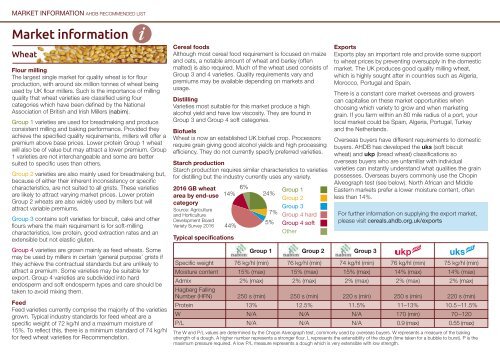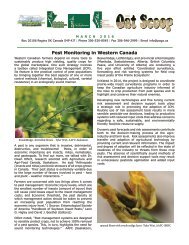AHDB Recommended Lists for cereals and oilseeds 2017/18
2mezhPE
2mezhPE
You also want an ePaper? Increase the reach of your titles
YUMPU automatically turns print PDFs into web optimized ePapers that Google loves.
MARKET INFORMATION <strong>AHDB</strong> RECOMMENDED LIST<br />
Market in<strong>for</strong>mation<br />
Wheat<br />
Flour milling<br />
The largest single market <strong>for</strong> quality wheat is <strong>for</strong> flour<br />
production, with around six million tonnes of wheat being<br />
used by UK flour millers. Such is the importance of milling<br />
quality that wheat varieties are classified using four<br />
categories which have been defined by the National<br />
Association of British <strong>and</strong> Irish Millers (nabim).<br />
Group 1 varieties are used <strong>for</strong> breadmaking <strong>and</strong> produce<br />
consistent milling <strong>and</strong> baking per<strong>for</strong>mance. Provided they<br />
achieve the specified quality requirements, millers will offer a<br />
premium above base prices. Lower protein Group 1 wheat<br />
will also be of value but may attract a lower premium. Group<br />
1 varieties are not interchangeable <strong>and</strong> some are better<br />
suited to specific uses than others.<br />
Group 2 varieties are also mainly used <strong>for</strong> breadmaking but,<br />
because of either their inherent inconsistency or specific<br />
characteristics, are not suited to all grists. These varieties<br />
are likely to attract varying market prices. Lower protein<br />
Group 2 wheats are also widely used by millers but will<br />
attract variable premiums.<br />
Group 3 contains soft varieties <strong>for</strong> biscuit, cake <strong>and</strong> other<br />
flours where the main requirement is <strong>for</strong> soft-milling<br />
characteristics, low protein, good extraction rates <strong>and</strong> an<br />
extensible but not elastic gluten.<br />
Group 4 varieties are grown mainly as feed wheats. Some<br />
may be used by millers in certain ‘general purpose’ grists if<br />
they achieve the contractual st<strong>and</strong>ards but are unlikely to<br />
attract a premium. Some varieties may be suitable <strong>for</strong><br />
export. Group 4 varieties are subdivided into hard<br />
endosperm <strong>and</strong> soft endosperm types <strong>and</strong> care should be<br />
taken to avoid mixing them.<br />
Feed<br />
Feed varieties currently comprise the majority of the varieties<br />
grown. Typical industry st<strong>and</strong>ards <strong>for</strong> feed wheat are a<br />
specific weight of 72 kg/hl <strong>and</strong> a maximum moisture of<br />
15%. To reflect this, there is a minimum st<strong>and</strong>ard of 74 kg/hl<br />
<strong>for</strong> feed wheat varieties <strong>for</strong> Recommendation.<br />
Cereal foods<br />
Although most cereal food requirement is focused on maize<br />
<strong>and</strong> oats, a notable amount of wheat <strong>and</strong> barley (often<br />
malted) is also required. Much of the wheat used consists of<br />
Group 3 <strong>and</strong> 4 varieties. Quality requirements vary <strong>and</strong><br />
premiums may be available depending on markets <strong>and</strong><br />
usage.<br />
Distilling<br />
Varieties most suitable <strong>for</strong> this market produce a high<br />
alcohol yield <strong>and</strong> have low viscosity. They are found in<br />
Group 3 <strong>and</strong> Group 4 soft categories.<br />
Biofuels<br />
Wheat is now an established UK biofuel crop. Processors<br />
require grain giving good alcohol yields <strong>and</strong> high processing<br />
efficiency. They do not currently specify preferred varieties.<br />
Starch production<br />
Starch production requires similar characteristics to varieties<br />
<strong>for</strong> distilling but the industry currently uses any variety.<br />
2016 GB wheat<br />
area by end-use<br />
category<br />
Source: Agriculture<br />
<strong>and</strong> Horticulture<br />
Development Board<br />
Variety Survey 2016<br />
Typical specifications<br />
6%<br />
14% 24%<br />
44%<br />
7%<br />
5%<br />
Group 1<br />
Group 1<br />
Group 2<br />
Group 3<br />
Group 4 hard<br />
Group 4 soft<br />
Other<br />
Group 2<br />
Exports<br />
Exports play an important role <strong>and</strong> provide some support<br />
to wheat prices by preventing oversupply in the domestic<br />
market. The UK produces good quality milling wheat,<br />
which is highly sought after in countries such as Algeria,<br />
Morocco, Portugal <strong>and</strong> Spain.<br />
There is a constant core market overseas <strong>and</strong> growers<br />
can capitalise on these market opportunities when<br />
choosing which variety to grow <strong>and</strong> when marketing<br />
grain. If you farm within an 80 mile radius of a port, your<br />
local market could be Spain, Algeria, Portugal, Turkey<br />
<strong>and</strong> the Netherl<strong>and</strong>s.<br />
Overseas buyers have different requirements to domestic<br />
buyers. <strong>AHDB</strong> has developed the uks (soft biscuit<br />
wheat) <strong>and</strong> ukp (bread wheat) classifications so<br />
overseas buyers who are unfamiliar with individual<br />
varieties can instantly underst<strong>and</strong> what qualities the grain<br />
possesses. Overseas buyers commonly use the Chopin<br />
Alveograph test (see below). North African <strong>and</strong> Middle<br />
Eastern markets prefer a lower moisture content, often<br />
less than 14%.<br />
For further in<strong>for</strong>mation on supplying the export market,<br />
please visit <strong>cereals</strong>.ahdb.org.uk/exports<br />
Group 3<br />
Specific weight 76 kg/hl (min) 76 kg/hl (min) 74 kg/hl (min) 76 kg/hl (min) 75 kg/hl (min)<br />
Moisture content 15% (max) 15% (max) 15% (max) 14% (max) 14% (max)<br />
Admix 2% (max) 2% (max) 2% (max) 2% (max) 2% (max)<br />
Hagberg Falling<br />
Number (HFN) 250 s (min) 250 s (min) 220 s (min) 250 s (min) 220 s (min)<br />
Protein 13% 12.5% 11.5% 11–13% 10.5–11.5%<br />
W N/A N/A N/A 170 (min) 70 –120<br />
P/L N/A N/A N/A 0.9 (max) 0.55 (max)<br />
The W <strong>and</strong> P/L values are determined by the Chopin Alveograph test, commonly used by overseas buyers. W represents a measure of the baking<br />
strength of a dough. A higher number represents a stronger flour. L represents the extensibility of the dough (time taken <strong>for</strong> a bubble to burst). P is the<br />
maximum pressure required. A low P/L measure represents a dough which is very extensible with low strength.



